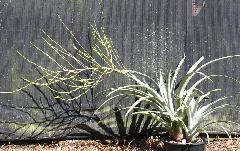
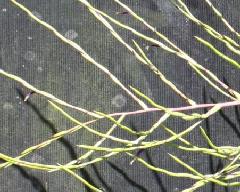

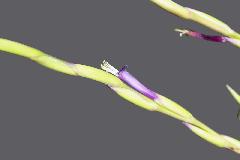



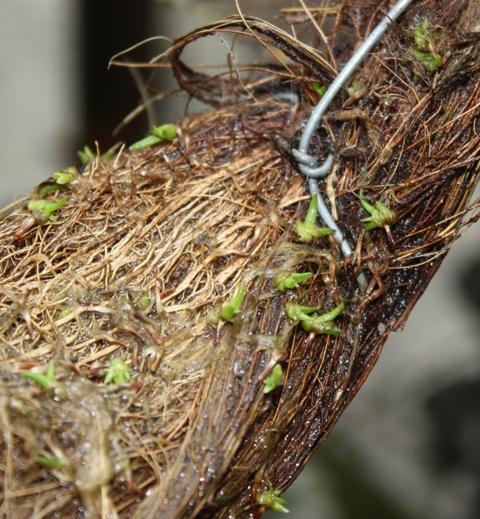
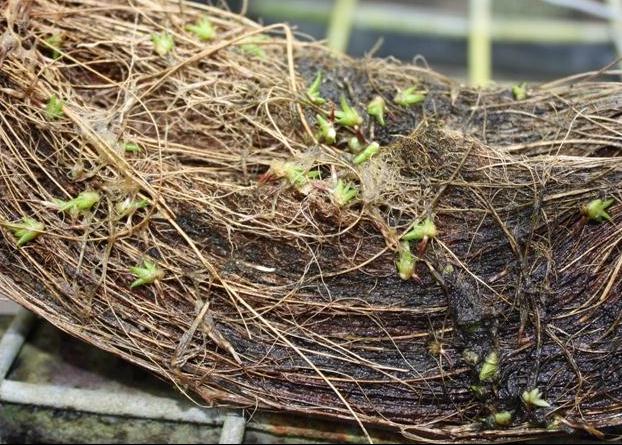
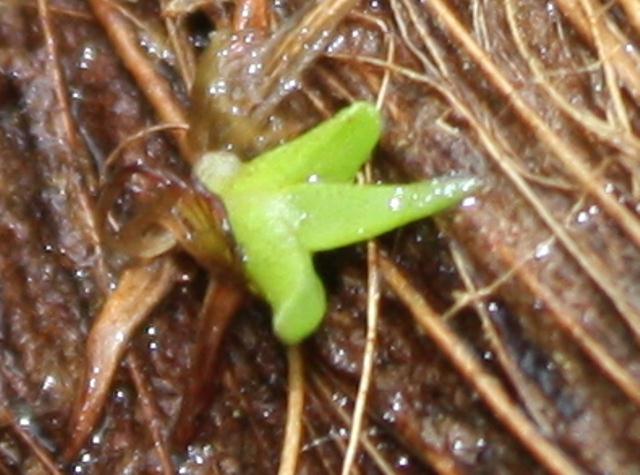
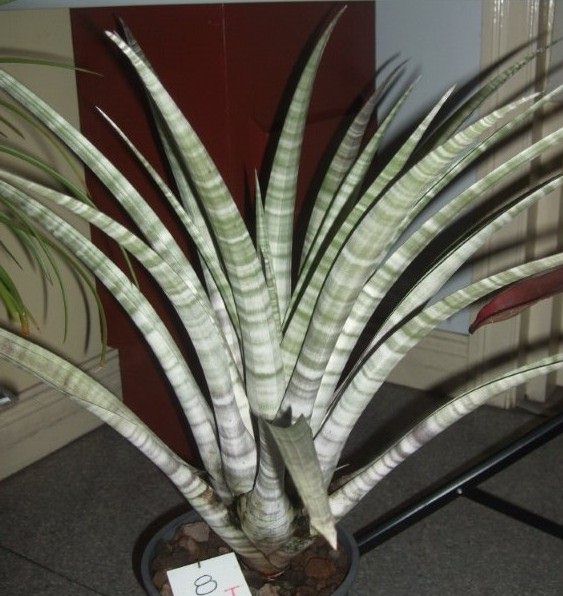

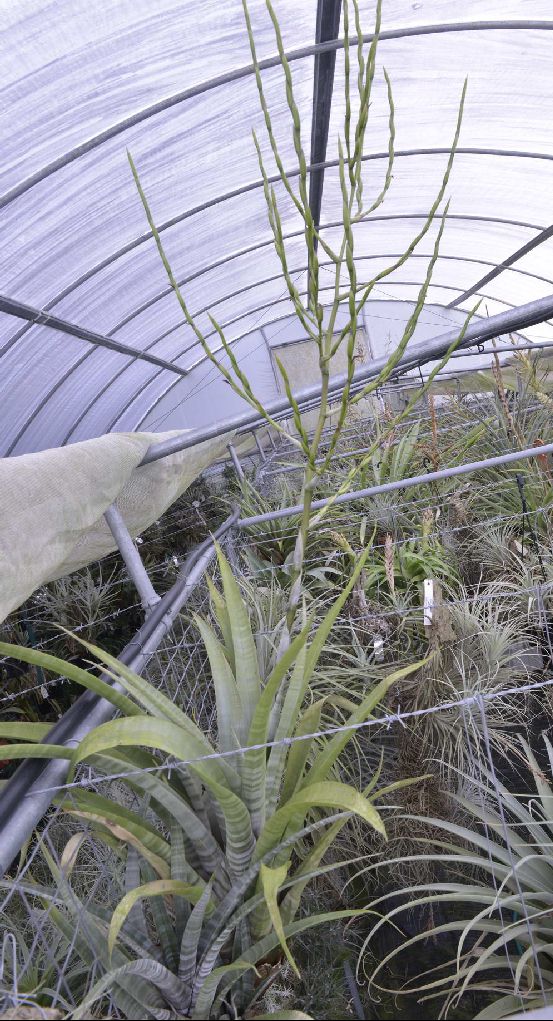
Desc from S&D p902
Plant stemless or short-caulescent, with basal offsets.
Leaves numerous in a funnelform rosette, stiffly erect, thick coriaceous, marked with broad white cross bands especially beneath;
Sheaths distinct, broadly ovate, 20 cm long, 13 cm wide, dark castaneous;
Blades subligulate, attenuate, 70 cm long, 8 cm wide, covered with pale appressed scales in the white bands but the scales only between the nerves in the dark bands.
Scape erect, to 1m long, 3 cm thick at base, blackish violet;
Scape-bracts densely imbricate, densely lepidote, the lower subfoliaceous, the upper ovate, acute.
Inflorescence very laxly tripinnate, pyramidal, 80 cm long, 90 cm wide; axis flexuous; Primary bracts like the upper scape bracts, exceeding the short bracteate sterile bases of the branches;
Spikes lax, to 20 cm long;
Rhachis flexuous, slender, dark violet.
Floral bracts erect, exceeding the internodes but much less than twice as long, ovate, acute, 25 mm long, exceeding the sepals, ecarinate, strongly nerved, subglabrous, the green margin drying purple.
Sepals narrowly ovate, apiculate, 20 mm long;
Petals tubular-erect, linear, 40-45 mm long, blue-violet;
Stamens and pistil exserted.
Type. Rauh 24319 (holotype HEID, isotype US), frequent on sheer cliffs, valley of Rio Chamaya, 1100 m alt, Cajamarca, Peru, Sep 1970.
DISTRIBUTION. Saxicolous, 1000-1100 m alt, Cajamarca, Peru.
PERU. CAJAMARCA: km113, Acapulco to Pucara, Rio Huancabamba, Jaen, 10 Jan 1964, Hutchison & Wright 3516 (UC, US, USM).
T. hildae ware nach dem Schlussel von L. B. SMITH (Phytologia, Vol. 20/3, 1970, p. 151) in den Verwandtschaftskreis der in Kolumbien beheimateten T. rariflora Andre zu stellen. Sie scheint mir jedoch naher verwandt zu sein mit der bislang nur unvollstandig beschriebenen und von Weberbauer zwischen San Pablo und San Miguel (Nord-Peru) gesammelten T. platyphylla MEZ., die vom Verf. an steilen Felswanden im Tal des Rio Utcubamba gesammelt werden konnte.
T. hildae ist mir bereits seit dem Jahre 1956 bekannt und wurde stets nur vegetativ angetroffen. Auch die im hiesigen Botanischen Garten kultivierten Exemplare sind bislang nicht zur Blute gelangt. Erst auf der letzten Peru-Reise im Jahre 1970 gelang es meiner Frau, Hilda Rauh, einige bluhende Exemplare zu sammeln. Ihr zu Ehren wurde deshalb die Pflanze mit dem Spezies-Namen hildae belegt.
T. hildae ist aufgrund der Blattzeichnung eine der auffalligsten und schonsten Tillandsien der peruanischen Trockentaler, die vegetativ eher an eine Aechmea als an eine Tillandsia erinnert. Nur die mexikanische T. leucolepsis MacDougall, zu der T. hildae keine verwandtschaftlichen Beziehungen aufweist, besitzt eine ahnliche Blattzeichnung. In der Kultur (Abb. 11) wird these noch viel intensiver, da am naturlichen Standort die weiBen Schuppen von einer dicken Staubschicht der stark verwitterten Felsen bedeckt sind.
T. hildae wachst nur an steilen, bruchigen und deshalb nahezu unzuganglichen Steilwanden (Abb. 9) des tief eingeschnittenen und niederschlagsarmen Trockentales des Rio Chamaya, einem NebenfluB des Rio Utcubamba, der bei Jaen in den Rio Maranon mundet. Sie tritt in Massenbestanden in Hohenlagen zwischen 800 und 1100 m auf und ist vergesell sehaftet mit Deuterocohnia longipetala, Peperomia dolabriformis (grau und dickblattrige Form) sowie Kakteen, Epostoa lanata, Trixanthocereus blossfeldiorum, Armatocereus rauhii, Seticereus chloracarpus ( ? ), Melocactus bellavistensis, Acacia macracantha und einer kleinblutigen Bombacaceae (Abb. 9).
Infolge der extremen Trockenheit des Standortes ist T. hildae ein ausgesprochener Xerophyt. Die Blatter sind sehr halt und derb und besitzen ein relativ dickes Wasserspeicherparenchym.
Hinsichtlich Blattform und Blattzeichnung scheint these Art variabel zu sein. Es wurden Formen gefunden mit auffallend schmalen Blattern und wenig ausgepragter Zeichnung und solche mit breiten Blattern und deutlicher Querbanderung. Die Variabilitat bleibt in der Kultur erhalten. Bemerkenswert ist ferner die tiefdunkelviolette, fast schwarze Farbung der Infloreszenzachse und der floralen Brakteen.
Translated by Derek Butcher:
T. hildae according to the Key by L. B. Smith, Phytologia, Vol. 20/3, 1970, p, 151, is in the complex with that of T. rariflora and others in Colombia. It seems to me however linked with the only incompletely described up to now and collected by Weberbauer between San Pablo and San Miguel (North-Peru) called T. platyphylla Mez, on steep rocks in the valley of Rio Utcubamba.
T. hildae was already known to me since1956 and was always found only vegetatively. Also the specimens cultivated in the local botanical garden have not reached the flowering stage up to now. Only on the last Peru trip in 1970, did my wife, Hilda Rauh, succeed in collecting some flowering specimens. It was in honour of her that this plant was given the name hildae.
T. hildae is one of the noticeable and beautiful Tillandsia of the Peruvian dry valleys, that looks vegetatively rather like an Aechmea than a Tillandsia, on the basis of the leaf markings. Only the Mexican T. leucolepsis MacDougall, to which T. hildae has no relation, has similar leaf markings. In cultivation (fig. 11), this becomes even much more intensive because the white scales of a thick dusty coating are worn away growing on rocks at the natural location.
T. hildae grows only on steep, broken and therefore virtually unwalkable steep areas (fig. 9), in the deeply incised and broken down dry valley of the Rio Chamaya, a tributary of the Rio Utcubamba, that joins at Jaen with the Rio Maranon. It grows on the high land between 800 and 1100 m in masses with Deuterocohnia longipetala, Peperomia dolabriformis, (grey and thick leaved form) , as well as Cactus, Espostoa lanata, Trixanthocereus blossfeldiorum, Armatocereus rauhii, Seticereus chloracarpus (? ), Melocactus bellavistensis, Acacia macracantha and a small flowered Bombacaceae (fig. 9).
T. hildae is, because of the extreme dryness of the location, called a xerophyte. The leaves are very hard and rough and have a relatively thick water storage parenchyma.
Regarding leaf form and leaf design, these seem to be variable. Forms were found with notably narrow leaves and little featured design and such with wide leaves and clear cross bands. This variability remains in cultivation. The deep dark violet, almost black colour of the inflorescence axis and the floral bracts is furthermore remarkable.